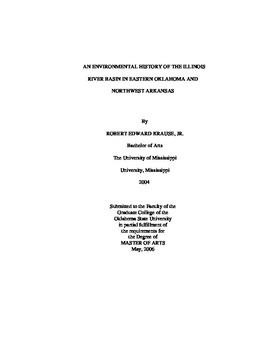| dc.contributor.advisor | Logan, Michael F. | |
| dc.contributor.author | Kraus, Robert Edward, Jr. | |
| dc.date.accessioned | 2014-04-15T21:50:41Z | |
| dc.date.available | 2014-04-15T21:50:41Z | |
| dc.date.issued | 2006-05-01 | |
| dc.identifier.uri | https://hdl.handle.net/11244/9070 | |
| dc.description.abstract | The purpose of this study is to examine the environmental history of the Illinois River watershed and basin in northeastern Oklahoma and northwest Arkansas, 1818-Present. Chapter one provides an introduction to the Illinois River and examines the historiography of scholarly and historical writing on the watershed region. Chapter two presents information on landforms and resource use in the watershed from 1818 to 1907. Chapter three deals with land-use and resource exploitation in the Illinois basin from 1907 through the contemporary period. The final chapter of this report investigates the history of preservation, conservation, and environmental protection and advocacy in the Illinois watershed. Accounts of early expeditions show that the Illinois River region was a diverse area in terms of ecosystems and land use. With the settlement of northwest Arkansas and Indian Territory by 1830, a subsistence-based agricultural society was developed through the mid 1800s and the Civil War. The aftereffects of the Civil War hindered development in the area until the emergence of cattle trails and railheads through Indian Territory and western Arkansas in the 1870s. Around the turn of the century, increased settlement and agricultural industrialization in the eastern half of the basin created a divergence in resource utilization between the two areas. Rapidly industrializing farmers in the northwest Arkansas Illinois River basin reaped the benefits of New Deal legislation and rural electrification programs in the 1930s, and poultry production became the most prevalent form of agriculture in the basin. Meanwhile, agricultural pursuits in the Oklahoma Illinois River basin remained non-industrial and sustainable in practice. When the Illinois River was designated as a state supported "Wild and Scenic River" in 1977, it was determined that pollution from poultry operations in Arkansas posed the primary threat to water quality in the river basin. For the last three decades, human impact on the Illinois River has grown with increasing recreation in the basin. Along with the enforcement of water quality standards at the Arkansas-Oklahoma state line, environmental awareness, education, and protection are all necessary to ensure the future integrity of the Illinois River basin. | |
| dc.format | application/pdf | |
| dc.language | en_US | |
| dc.publisher | Oklahoma State University | |
| dc.rights | Copyright is held by the author who has granted the Oklahoma State University Library the non-exclusive right to share this material in its institutional repository. Contact Digital Library Services at lib-dls@okstate.edu or 405-744-9161 for the permission policy on the use, reproduction or distribution of this material. | |
| dc.title | Environmental History of the Illinois River Basin in Eastern Oklahoma and Northwest Arkansas | |
| dc.type | text | |
| dc.contributor.committeeMember | Huston, James | |
| dc.contributor.committeeMember | Petrin, Ronald | |
| osu.filename | KrauseJr_okstate_0664M_1712.pdf | |
| osu.college | Arts and Sciences | |
| osu.accesstype | Open Access | |
| dc.description.department | Department of History | |
| dc.type.genre | Thesis | |
| dc.subject.keywords | environmental history | |
| dc.subject.keywords | oklahoma | |
| dc.subject.keywords | illinois river | |
| dc.subject.keywords | arkansas | |
| dc.subject.keywords | agricultural history | |
